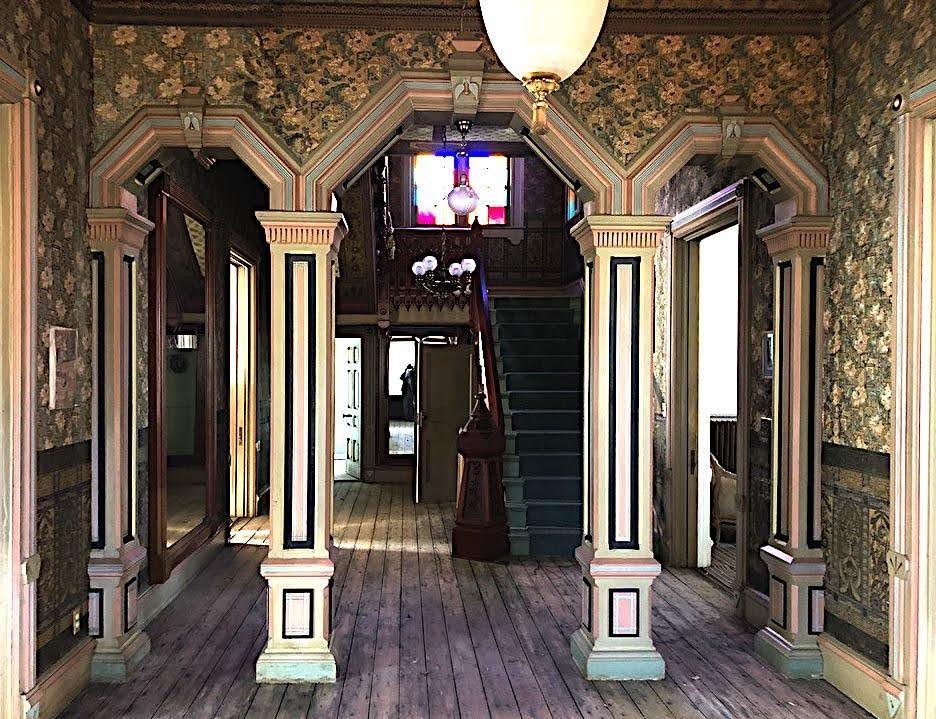
Laurel Hall Mansion + Laurel Glen Mausoleum
Visit the elegant home and heartbreaking mausoleum honoring one mourning businessman’s lost family.
An expression of wealth and grief…
John P. Bowman was a grief-stricken man in 1880 following the deaths of his beloved wife Jennie and young daughter Ella; their first daughter Addie had previously died at just four months old. Bowman resolved to build a magnificent final resting place for them, and then an elegant mansion overlooking the cemetery where he could live out his days. Scroll down to read his story...
-

LAUREL HALL MANSION
Built in 1882 so that Bowman could spend the rest of his years looking over the mausoleum across the street.
-

LAUREL GLEN CEMETERY AND MAUSOLEUM
Built in 1880 to honor Bowman’s lost wife and daughters.
-

VISIT
Learn more about how schedule a tour of the mansion or plan your own visit to the cemetery and mausoleum.
-

DONATE
The Laurel Glen Cemetery Association of 1894 is a non-profit group that relies on donations from the public to maintain these properties in perpetuity.
-
The Sorrowful Story of John Bowman
John P. Bowman, born 1816
John Porter Bowman was born in Clarendon, VT in 1816. He first went to work in a tannery in Rutland, VT, at the age of 15 until he mastered the trade, and in the 1840s he established his own tannery in Cuttingsville, just down the road from where his mansion now stands. Bowman’s leather tanning developed an excellent reputation, and through his Cuttingsville tannery and another he purchased in Stony Creek, NY, Bowman eventually became a wealthy man.
In addition to his business ventures, during this time John Bowman was building a family. In 1849 he married Jane “Jennie” Eunice Gates (1824-1880), and five years later in 1854 they welcomed their first daughter, Addie. Tragically, Addie died just four months later, likely of scarlet fever. Two years after that the couple gave birth to their second daughter Ella on October 30, 1856.
Jane “Jennie” Bowman, born 1824
For a time, the family appears to have lived well. Bowman amassed his fortune during the American Civil War by supplying the Union Army with leather equipment. He sold leather for goods such as tack, saddles, and harnesses to the public, but his shoe and boot soles were hailed as the best on the market. Bowman’s business grew rapidly, allowing him to build a boarding house for his single employees and sixteen houses for men with families. (History of Warren County, H. P. Smith) Records from Stony Creek show that in 1875, while the average male in the US made $17 a month, employees of Mr. Bowman made $32 a month.
Tragedy struck for John Bowman in 1879. His daughter Ella, then 22 years old, developed an intense illness (likely tuberculosis) and died suddenly on June 25, 1879. A few months later, in January of 1880, her mother died suffering similar symptoms. John Bowman found himself a widower, with both of his daughters lost.
Ella Bowman, 1856-1879
In the depth of his grief, he decided to build a heartbreaking mausoleum to honor his family, and a mansion from which to observe the mausoleum. The mausoleum was located on the edge of the Cuttingsville Cemetery, called Laurel Glen, and mansion, Laurel Hall, was placed across the street and directly overlooking the mausoleum.
Visitors are invited to visit both the mausoleum, which is accessible to the public year round (though the sculpture of John Bowman in front is under cover through the winter months) and the mansion has been maintained as a museum and is accessible to visitors through scheduled tours; email to schedule a visit.
Photo by Chryl Martin



